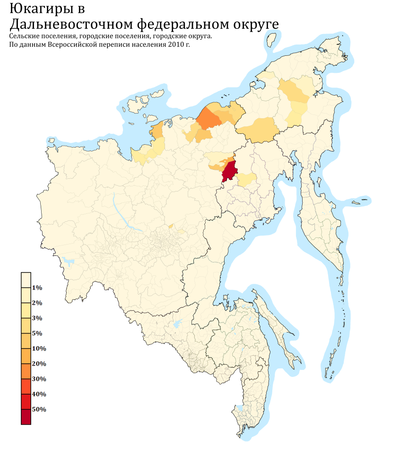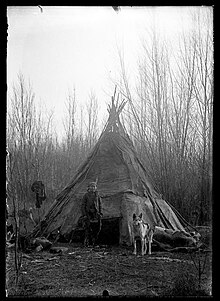Yukaghir people
This article has multiple issues.Please helpimprove itor discuss these issues on thetalk page.(Learn how and when to remove these template messages)
|
деткиль, одул, вадул, алаи | |
|---|---|
 Yukaghirs from Yakutia, 1905. | |
| Regions with significant populations | |
| 1,802[1] |
| 12[2] | |
| Languages | |
| Yukaghir,Russian,Yakut | |
| Religion | |
| Shamanism,Russian Orthodoxy | |
TheYukaghirs,orYukagirs(Northern Yukaghir:одул, деткиль(odul, detkil),Russian:юкаги́ры), are aSiberianethnic groupin theRussian Far East,living in thebasinof theKolyma River.
Geographic distribution
[edit]
The Tundra Yukaghirs live in the Lower Kolyma region in theSakha Republic;the Taiga Yukaghirs in the Upper Kolyma region in the Sakha Republic and inSrednekansky DistrictofMagadan Oblast.By the time of Russiancolonizationin the 17th century, the Yukaghir tribal groups occupied territories from theLena Riverto the mouth of theAnadyr River.The number of the Yukaghirs decreased between the 17th and 19th centuries due toepidemics,internecine wars andTsaristcolonial policy which may have included genocide against the sedentary hunter-fisher Anaouls. Some of the Yukaghirs have assimilated with theYakuts,Evens,andRussians.
Currently, Yukaghirs live in theSakha Republicand theChukotka Autonomous Okrugof the Russian Federation. According to the 2002 Census, their total number was 1,509 people, up from 1,112 recorded in the1989 Census.
According to the latest 2001 all Ukrainian census, 12 Yukaghirs are living inUkraine.Only 2 of them indicatedYukaghiras their native language. For the remaining others (6) it isRussianand for 1 it is some other tongue.[2]
Genetics
[edit]Genetically, Yukaghirs exhibit roughly equal frequencies of theY-DNA haplogroupsN1c,Q1,andC2(formerly C3).[3]
According to another study, out of 11 Yukaghir males 3 turned out to belong to the Y-haplogroup N1c (different subclade from the one found in Yakuts), another 4 - to the Y-haplogroup C2 (former C3; for the most part, the same subclade that's also found inKoryaks), one more - to the Y-haplogroup O,and the rest 3 exhibit apparent Russian genetic influence (two individuals belonging to the Y-haplogroup R1a,and one more - to the Y-haplogroup I2a). The study also found no similarities between Yukaghirs andChukchisin regards tomitochondrial DNA.[4]
Subethnic groups
[edit]
Modern Yukaghirs are thought to be descendants of the late NeolithicYmyyakhtakh culture.[5]
The 13 tribes that once constituted the Yukaghir group are:Vadul-Alais,Odul,Chuvan,Anaoul,Lavren,Olyuben,Omok,Penjin,Khodynts,Khoromoy,Shoromboy,Yandin,and Yandyr.
The surviving three tribes are the Odul of Nelemnoe, the Vadul ofAndryushkinoand the Chuvan of the Anadyr river area. Of the extinct groups, the most important were the Khodynts, the Anaoul (both of the Anadyr River area), and the Omok (north of the Chuvan). Sometimes the Chuvan are considered a separate tribe. The Chuvantsy language has been extinct since the early 20th century. In 2002, 1,087 identified themselves as Chuvan compared to more than 1,300 in 1989. The Vadul are mainly involved in reindeer herding while the Odul (Kogime) are mostly hunter-gatherers. The Vadul are also known as Tundra Yukaghir. The Odul are also known as Taiga Yukaghir or Kolyma Yukaghir. The Vadul and Odul languages are as different asGermanis fromDutch.Both are nearing extinction, and Odul is in a much weaker state compared to Vadul. In the 1989 census, more than 700 of the Yukaghirs identified as Vadul while fewer than 400 were Odul.
The Yukaghir are one of the oldest peoples in North-Eastern Asia. Originally they lived over a huge territory from Lake Baikal to the Arctic Ocean. By the time of the first encounter with Russians, Yukaghir were divided into twelve tribes with around 9,000 people. The Yukagir ethnonym isOdulorVadul,which means “mighty”.
Tribal divisions among the Yukaghir are fading now, although in every census from 1926, significant number of tribesmen identified themselves with tribal divisions like Anaoul, Odul and Vadul rather than describing themselves as Yukaghir. The Soviet government actively discouraged this tendency and now only the most elderly identify this way. In the 2002 census, out of the 1,509 Yukaghirs, 51 identified themselves as Omok, 40 as Alais, 21 as Odul, 17 as Vadul, 6 as Khangait and 4 as Detkil.
Clan system
[edit]The head of every clan was an elder called aLigey Shomorokh.His was the final word in all aspects of life. Hunting leaders wereKhangitche,and war leaders wereTonbaia Shomorokh( "the mighty man" ). Women and teenagers had equal voices with men. The internal life of the community was under the control of the older women. Their decisions in those matters were indisputable.
In the beginning of every summer all clans gathered for theSakhadzibefestival, where mutual Yukaghir questions were discussed.
In the Yakut-Sakha Republic there are three nomadic extended family communities. These are Tchaila inNizhnekolymsky District,Teki Odulok inVerkhnekolymsky Districtand Ianugail inUst-Yansky District.The head of Ianugail is I. I. Tomsky. The community's main activities are deer hunting and fishing. Tchaila is the biggest of the three. Its head is S. I. Kurilov. They have 4000 domesticated reindeer, 200 horses, and 20 cows. The community also hunts deer and polar foxes. There is also a shop where traditional skin and fur garments are made. The head of Teki Odulok is N. I. Shalugin. Their base is the village of Nelemnoe. This community is in the most difficult situation. Due to the “creative interpretation” of various Perestroika and privatization laws by the local and district administration and so-called businessmen, the community has lost all their reindeer, cows and even part of its land. All they have left are about 50 horses. They have no money for supplies for hunting and fishing. 80% of all adult population isde factounemployed.
The highest forum for Yukagir is the all-people gatheringSuktuul.
Culture
[edit]

The main traditional activity is nomadic and semi-nomadic hunting of deer, moose, wild sheep, and sable, as well as fishing. Reindeer are bred mostly for transportation.Horsesare known among the Yukaghir as "domestic reindeer ofYakuts"(Yoqod ileinTundra YukaghirorYaqad āçəinKolyma Yukaghir). A Yukaghir house is called achum.
The decline of traditional economic activities, the unfavorable environmental situation of the Yukaghir's traditional lands and waters, and the absence of local and federal laws and executive mechanisms protecting indigenous peoples in Russia, have not aided the welfare and continuation of traditional Yukaghir communities. The average life span for men is 45 years, and 54 years for women. Child mortality is the highest in the Yakut-Sakha Republic. In addition, one expedition made to the Yukaghir found that most had no knowledge of traditional Yukaghir culture.
Language
[edit]TheYukaghir languagesare a small language family of two closely related languages, Tundra Yukaghir and Kolyma Yukaghir, although there used to be more. They are unclassified languages: their origin and relation to other languages are unknown; some scholars consider them distantly related to theUralic languages,[6]but this classification is not accepted by the majority of specialists in Uralic linguistics. The languages are regarded as moribund, since less than 370 people can speak either Yukaghir language. Most Yukaghirs today speakYakutandRussian.
Religion
[edit]Alongside Russian Orthodox beliefs, Yukaghirs practiceshamanism.The dominant cults are ancestral spirits, the spirits of Fire,Sun (Pugu),Hunting, Earth, and Water, which can act as protectors or as enemies of people. The most important is the cult ofPugu,the Sun, who is the highest judge in all disputes. The spirits of the dead go to a place calledAibidzi.Every clan had a shaman called analma.After death everyalmawas treated as a deity, and the body of the deadalmawas dismembered and kept by the clan as relics. The Yukaghir still continue traditions stemming from their origins as nomadic reindeer-hunters: they practice dog sacrifice and have an epic poem based around crows. The animal cult was especially strong in the elk cult. There was a number of rituals and taboos connected with elk and deer hunting.[7]
See also
[edit]References
[edit]Notes
[edit]- Nikolaeva, Irina; Mayer, Thomas (2004)."Online Documentation of Kolyma Yukaghir".Suomalais-Ugrilainen Seura (Finno-Ugrian Society, Société Finno-Ougrienne).Also free online available audio materials (tales, songs).
- Vaba, Lembit."The Yukaghirs".The Red Book of the Peoples of the Russian Empire.NGO Red Book.
- "Yukaghirs".Inside the New Russia.SC Publishing. 1994.
Footnotes
[edit]- ^"Росстат — Всероссийская перепись населения 2020".rosstat.gov.ru.Retrieved2023-01-03.
- ^abState statistics committee of Ukraine - National composition of population, 2001 census(Ukrainian)
- ^Duggan, Ana T.; Whitten, Mark; Wiebe, Victor; Crawford, Michael; Butthof, Anne; Spitsyn, Victor; Makarov, Sergey; Novgorodov, Innokentiy; Osakovsky, Vladimir; Pakendorf, Brigitte (2013)."Investigating the Prehistory of Tungusic Peoples of Siberia and the Amur-Ussuri Region with Complete mtDNA Genome Sequences and Y-chromosomal Markers".PLOS ONE.8(12): e83570.Bibcode:2013PLoSO...883570D.doi:10.1371/journal.pone.0083570.PMC3861515.PMID24349531.
- ^Fedorova, Sardana A.; Reidla, Maere; Metspalu, Ene; Metspalu, Mait; Rootsi, Siiri; Tambets, Kristiina; Trofimova, Natalya; Zhadanov, Sergey I.; Hooshiar Kashani, Baharak; Olivieri, Anna; Voevoda, Mikhail I.; Osipova, Ludmila P.; Platonov, Fedor A.; Tomsky, Mikhail I.; Khusnutdinova, Elza K. (2013)."Autosomal and uniparental portraits of the native populations of Sakha (Yakutia): implications for the peopling of Northeast Eurasia".BMC Evolutionary Biology.13(1): 127.Bibcode:2013BMCEE..13..127F.doi:10.1186/1471-2148-13-127.PMC3695835.PMID23782551.
- ^Эверстов, Степан (2014)."Некоторые параллели в культурах древних ымыяхтахцев и юкагиров XVII-XIX вв"[Some cultural parallels between the ancient Ymyyakhtakh and the 17-19th century Yukaghirs].Арктика и Север(in Russian) (15).Retrieved2024-01-27.
- ^Nikolaeva & Mayer 2004,ch. “About the Yukaghirs”
- ^Inside the New Russia (1994): Yukagirs
External links
[edit]- Yukaghir portalin Arctic Megapedia(in Russian)
- Irina Kurilova's channel(mostly Yukaghir-related videos, sometimes featuring other indigenous peoples of Yakutia)(in Russian)
Modern culture:
- Irina Duskulova - "Chakhadan" (live, w/ English subtitles)
- Irina Duskulova - "Ulegen Nume" (music video)
- Irina Duskulova - "Shakhadjibe" (music video, 2023)
- Concert @ 5th Yukaghir congress(20 March 2016)
- Yukaghir folk singer Ragtyna Tymkal
- Den Pobedyin Yukaghir by Anastasia Kurilova
- Ave Mariain Yukaghir by Yakut singer Saina
- Yukaghir people
- Ethnic groups in Russia
- Ethnic groups in Siberia
- Indigenous peoples of Siberia
- Indigenous small-numbered peoples of the North, Siberia and the Far East
- Hunter-gatherers of Asia
- Modern nomads
- Nomadic groups in Eurasia
- People from Chukotka Autonomous Okrug
- People from Magadan Oblast
- People from the Sakha Republic
